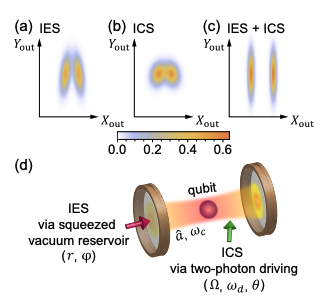Researchers have discovered that simultaneous use of injected external squeezing (IES) and intracavity squeezing (ICS) can exponentially improve the signal-to-noise ratio (SNR) in dispersive qubit readout (DQR), a key component of quantum error correction and fault-tolerant quantum computation. Previous research found that IES and ICS used separately resulted in negligible SNR improvement. The team’s approach, which maps qubit state information onto a Bogoliubov mode of the cavity, could lead to faster, more accurate quantum computations and have applications in other areas of quantum technology.
Can Squeezed Light Improve Dispersive Qubit Readout?
A team of researchers from the Center for Joint Quantum Studies and Department of Physics at Tianjin University, Theoretical Quantum Physics Laboratory Cluster for Pioneering Research RIKEN, Institute of Spintronics and Quantum Information Faculty of Physics at Adam Mickiewicz University, Center for Quantum Computing RIKEN, and Department of Physics at The University of Michigan have been exploring the potential of squeezed light in improving dispersive qubit readout (DQR).
DQR is a crucial component of quantum error correction and fault-tolerant quantum computation. It involves the measurement of a qubit that is dispersively coupled to a cavity, which acts as the pointer. The qubit-state-dependent cavity resonance shift is then measured by homodyne detection. This process needs to be fast and of high fidelity, and the use of squeezed states of light to improve this readout is highly desirable.
However, previous research has shown that injected external squeezing (IES) cannot significantly improve the signal-to-noise ratio (SNR) in a practically feasible way. This is due to a qubit-state-dependent rotation of squeezing, which increases the overlap of the two pointer states. Similarly, the use of intracavity squeezing (ICS) has also been found to result in negligible improvement in the SNR.
Can Simultaneous Use of IES and ICS Improve DQR?
The researchers have demonstrated that when IES and ICS are applied simultaneously, the readout SNR can have an exponential improvement for any measurement time. In this approach, the qubit state information is mapped onto a Bogoliubov mode of the cavity rather than the bare cavity mode as usual. This ensures a strong and measurement-time-independent degree of squeezing and at the same time avoids the qubit-state-dependent rotation of squeezing.
This results in an exponential decrease in the overlap of the pointer states, which is in sharp contrast to the case of using IES or ICS alone. A previous approach that can exponentially improve the SNR of DQR has been proposed based on a quantum-mechanics-free subsystem. However, it requires injecting two-mode squeezed light into two coupled cavities and measuring a pair of readout modes. In contrast, the researchers’ approach relies on a single cavity and single-mode squeezed light, making it more suitable for standard readout.
What is the Potential Impact of this Research?
The researchers found that in their approach, the resulting SNR can scale as e2r for short-time measurements, indicating a fast and high-fidelity readout. This giant improvement arises due to two aspects: one from anti-squeezed vacuum fluctuations, which amplify the qubit-cavity dispersive coupling and thus the signal separation, and the other from squeezed vacuum fluctuations, which reduce the measurement noise.
This work offers a promising path toward exploring squeezed light for dispersive qubit readout with immediate applications in quantum error correction and fault-tolerant quantum computation. The use of squeezed light has been widely used for various applications including quantum key distribution, mechanical cooling, light-matter interaction enhancement, and even quantum advantage demonstration.
How Does the Physical Model Work?
The key idea underlying the researchers’ proposal is shown in their physical model. The qubit is coupled to the cavity via a detuned Jaynes-Cummings interaction with strength g, as in the simplest strategy of DQR. The annihilation-creation operator of the cavity mode and the lowering-raising operator of the qubit are assumed to be a squeezed vacuum reservoir.
This research represents a significant step forward in the field of quantum computing, demonstrating the potential of squeezed light to exponentially improve the SNR of DQR. The findings could have far-reaching implications for the development of high-precision quantum measurements and the advancement of quantum technologies.
What are the Future Implications of this Research?
The findings of this research could have significant implications for the future of quantum computing. The ability to improve the SNR of DQR exponentially could lead to faster and more accurate quantum computations, which would be a major advancement in the field.
Furthermore, the research could also have applications in other areas of quantum technology, such as quantum key distribution and mechanical cooling. The use of squeezed light in these applications could lead to significant improvements in their performance and efficiency.
In conclusion, this research represents a significant step forward in quantum computing and could have far-reaching implications for the future of quantum technology. The researchers’ innovative approach to improving DQR using squeezed light could pave the way for more accurate and efficient quantum computations.
Publication details: “Exponentially Improved Dispersive Qubit Readout with Squeezed Light”
Publication Date: 2024-02-19
Authors: Wei Qin, Adam Miranowicz and Franco Nori
Source: arXiv (Cornell University)
DOI: https://doi.org/10.48550/arxiv.2402.12044

